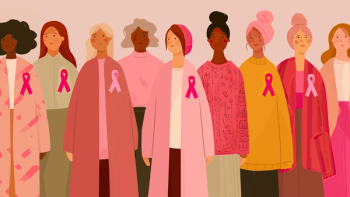
Surgery With Chemotherapy Extended Progression-Free Survival in Relapsed Ovarian Cancer
Patients with platinum-sensitive relapsed ovarian cancer who underwent surgery then chemotherapy had a progression-free survival of 17.4 months compared with 11.9 months in those who underwent chemotherapy alone.
Secondary cytoreduction then chemotherapy as a treatment option for patients with platinum-sensitive relapsed ovarian cancer contributed to longer progression-free survival compared with chemotherapy alone, according to a study published in The Lancet Oncology.
Secondary cytoreduction refers to surgery to debulk a tumor in patients with recurrent disease who previously completed primary treatment with a period of time of remission.
“All patients should be counseled about the options of secondary cytoreduction in specialized centers with high volumes of ovarian cancer surgery,” the study authors wrote.
Most patients — 80% — with ovarian cancer will relapse after first-line treatment with chemotherapy and targeted maintenance therapy. Secondary cytoreduction is a widely practiced option for patients with platinum-sensitive relapsed disease, although it is often seen as controversial. Data have yet to show whether secondary cytoreduction leads to a survival benefit in patients, and this surgery is not an appropriate option for all patients.
Researchers enrolled 357 patients with platinum-sensitive relapsed epithelial ovarian cancer. In particular, these patients had at least six months between when they completed their first-line chemotherapy and disease progression. Patients were assigned either secondary cytoreduction and chemotherapy (or the surgery group; 182 patients; median age, 55 years) or chemotherapy alone (or the no surgery group; 175 patients; median age, 53 years).
This study aimed to compare secondary cytoreduction and chemotherapy with chemotherapy alone and had a focus on progression-free survival (time from treatment assignment to disease progression or all-cause death), overall survival (time from treatment assignment and all-cause death) and safety. Patients in the surgery group were followed for a median of 36 months compared with 33.9 months in the no surgery group.
Of the patients in the no surgery group, 6% underwent secondary cytoreduction during second-line therapy. In addition, 37% of the 130 patients who had disease progression in the no surgery group crossed over into the surgery group and underwent surgery for another recurrence.
Median progression-free survival in patients in the surgery group was 17.4 months compared with 11.9 months in the no surgery group. Patients assigned surgery had a median overall survival of 58.1 months versus 53.9 months in those assigned chemotherapy alone.
At 30 days, surgical complications leading to severe or worse side effects (also considered surgical morbidity) occurred in 5% of patients assigned surgery. No patients died in either group 60 days after receiving treatment.
When chemotherapy was administered in the surgery and no surgery groups, the most common severe or life-threatening side effects were low number of a type of white blood cell called neutrophils (17% versus 12%, respectively), anemia (6% versus 6%) and low white blood cell counts affecting the ability to fight infection (8% versus 5%, respectively). Four serious side effects occurred in the surgery group related to low number of neutrophils and increased blood creatinine indicating impaired kidney function. No patients in the chemotherapy-only group had serious side effects. In addition, both groups had no treatment-related deaths throughout the study.
“Long-term survival outcomes will be assessed using mature data on overall survival and accumulating treatment-free survival,” the study authors wrote.
For more news on cancer updates, research and education, don’t forget to




